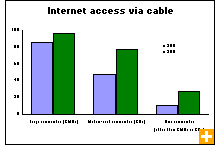Common menu bar links
Internet access in rural communities
Archived Content
Information identified as archived is provided for reference, research or recordkeeping purposes. It is not subject to the Government of Canada Web Standards and has not been altered or updated since it was archived. Please contact us to request a format other than those available.
The Internet is everywhere . well, almost everywhere. Whether you use it at school for historical research, at work for financial market updates or at home for health care information, having reliable high-speed access to the Internet is both convenient and helpful. But for many in rural and remote communities, broadband Internet service can be simply too difficult and costly to access and provide.
According to Industry Canada, 72% of Canadian communities and 14% of the population did not have broadband service available in 2003. High-speed Internet by cable was available in virtually all large communities, but only in 27% of smaller centres.
Building the infrastructure needed to provide broadband services to rural communities often does not make economic sense for broadband providers, given the smaller potential subscriber base and the fact that customers are dispersed over greater distances. Many rural consumers have turned to satellite-based Internet connections as an option. However, connection and equipment prices are high and many providers only offer one-way access, so a dial-up connection is still necessary to receive return signals.
 Farmers
are using the Internet to gain market knowledge in such areas as real-time
pricing, weather reports and market sales. On all farms using computers,
about 70% use the Internet for business purposes. Rural physicians use the
Internet routinely to check drug information resources. Various types
of telemedicine, including the transmission of echocardiographic images and
electronic referrals between primary and secondary health care providers,
are now commonplace in both rural and urban settings. And rural consumers
in places such as Grise Fiord, Canada's
northernmost settlement, are reaping the benefits of free shipping offered
by certain e-commerce sites.
Farmers
are using the Internet to gain market knowledge in such areas as real-time
pricing, weather reports and market sales. On all farms using computers,
about 70% use the Internet for business purposes. Rural physicians use the
Internet routinely to check drug information resources. Various types
of telemedicine, including the transmission of echocardiographic images and
electronic referrals between primary and secondary health care providers,
are now commonplace in both rural and urban settings. And rural consumers
in places such as Grise Fiord, Canada's
northernmost settlement, are reaping the benefits of free shipping offered
by certain e-commerce sites.
Recognizing the application of the Internet in health, education, business and other areas, the Canadian government has made nationwide broadband connectivity a priority for completion by 2005, especially for rural areas. Currently, Canada has the highest cable broadband coverage of all Organisation for Economic Co-operation and Development (OECD) countries, despite the challenges posed by our geography.


